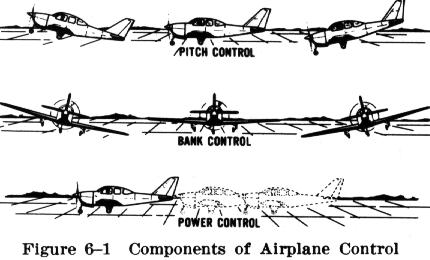The attitude indicator (artificial horizon), heading indicator, altimeter, vertical speed indicator, and airspeed indicator, are the instruments used as references for control of the airplane. The attitude

| Airplane control is composed of three components: (1) pitch
control, (2) bank control, and (3) power control (Fig. 6-1). Pitch control
is the control of the airplane about its lateral axis by applying elevator
pressure to raise or lower the nose, usually in relation to the horizon.
Bank control is the control of the airplane about its longitudinal axis
by use of the ailerons to attain the desired angle of bank in relation
to the horizon. Power control is the control of power or thrust by use
of the throttle to establish or maintain desired airspeeds in coordination
with the attitude changes.
The attitude indicator (artificial horizon), heading indicator, altimeter, vertical speed indicator, and airspeed indicator, are the instruments used as references for control of the airplane. The attitude |
 |
The objectives in these basic maneuvers are to learn the proper use of the controls for maneuvering the airplane, to attain the proper attitude in relation to the horizon by use of inside and outside references, and to emphasize the importance of dividing attention and constantly checking all reference points.